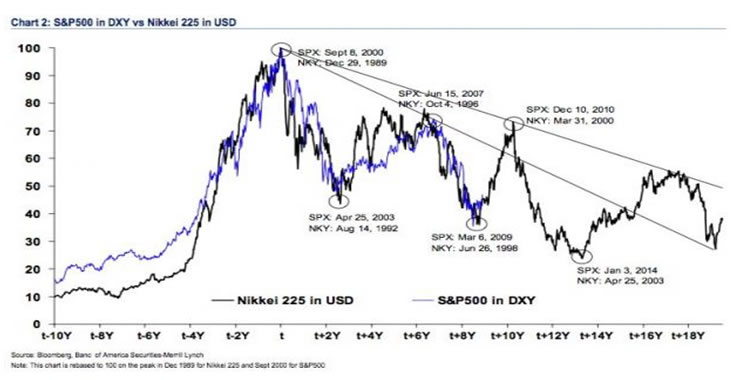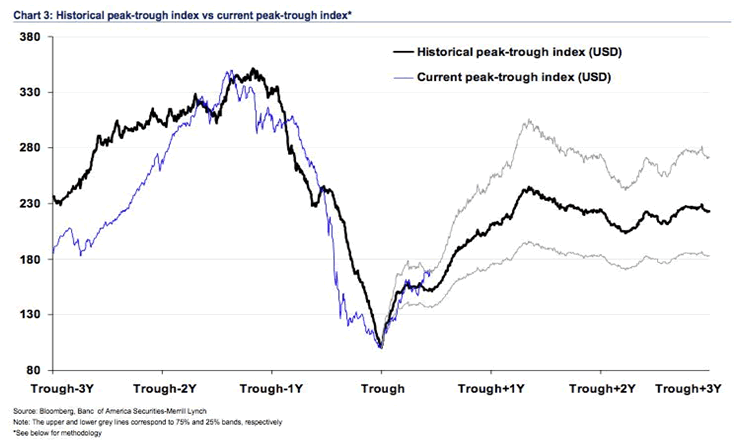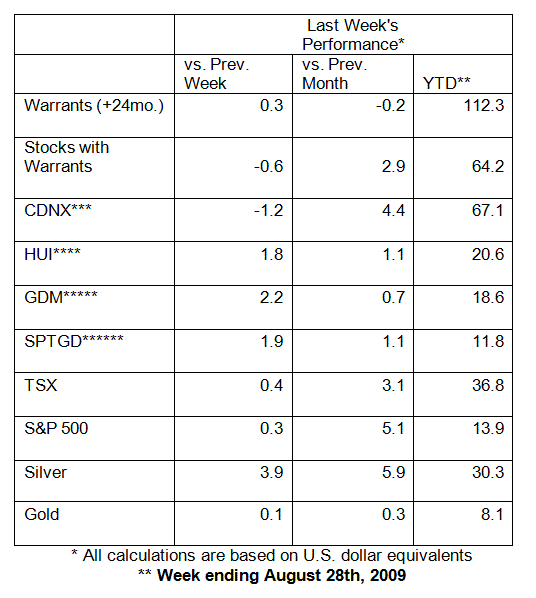Click here for a link to complete ORIGINAL article:
By John Mauldin | 29 January 2010
The Statistical Recovery has Arrived
This Time Is Different
A Crisis of Confidence
Greeks Bearing Gifts
Biotech, Conversations and Babies
|
I have just returned from Europe, and the discussion often turned to the potential of a crisis in the Eurozone if Greece defaults. Plus, we take a look at the very positive US GDP numbers released this morning. Are we finally back to the 'Old Normal'? There's just so much to talk about.
At the end of the letter I am going to comment on my latest Conversations with two of the leading lights in the biotech world and give you a link to my recent Outside the Box on biotech, which has had more response than almost any letter I have posted. If you missed it, you should read it, as I outline why I am actually buying stocks in the biotech space, even as I think we are headed for a double-dip recession and a rather sharp bear market. But now, let's jump into today's letter.
The Statistical Recovery Has Arrived
Before we get into the main discussion point, let me briefly comment on today's GDP numbers, which came in at an amazingly strong 5.7% growth rate. While that is stronger than I thought it would be (I said 4-5%), there are reasons to be cautious before we sound the "all clear" bell.
First, over 60% (3.7%) of the growth came from inventory rebuilding, as opposed to just 0.7% in the third quarter. If you examine the numbers, you find that inventories had dropped below sales, so a buildup was needed. Increasing inventories add to GDP, while, counterintuitively, sales from inventory decrease GDP. Businesses are just adjusting to the New Normal level of sales. I expect further inventory build-up in the next two quarters, although not at this level, and then we level off the latter half of the year.
While rebuilding inventories is a very good thing, that growth will only continue if sales grow. Otherwise inventories will find the level of the New Normal and stop growing. And if you look at consumer spending in the data, you find that it actually declined in the 4th quarter, both annually and from the previous quarter. "Domestic demand" declined from 2.3% in the third quarter to only 1.7% in the fourth quarter. Part of that is clearly the absence of "Cash for Clunkers," but even so that is not a sign of economic strength.
Second, as my friend David Rosenberg pointed out, imports fell over the 4th quarter. Usually in a heavy inventory-rebuilding cycle, imports rise because a portion of the materials businesses need to build their own products comes from foreign sources. Thus the drop in imports is most unusual. Falling imports, which is a sign of economic retrenching, also increases the statistical GDP number.
Third, I have seen no analysis (yet) on the impact of the stimulus spending, but it was 90% of the growth in the third quarter, or a little less than 2% [[of the overall GDP number: normxxx]].
Fourth (and quoting David):
|
Finally, remember that third-quarter GDP was revised downward by over 30%, from 3.5% to just 2.2% only 60 days later. (This is the first release, to be followed by revisions over the next two months.) The first release is based on a lot of 'estimates', otherwise known as guesswork. The fourth-quarter number is likely to be revised down as well.
Unemployment rose by several hundred thousand jobs in the fourth quarter, and if you look at some surveys, it approached 500,000. That is hardly consistent with a 5.7% growth rate. Further, sales taxes and income-tax receipts are still falling.
As I said last year that it would be, this is a Statistical Recovery. When unemployment is rising, it is hard to talk of real recovery. Without the stimulus in the latter half of the year, growth would have been much slower.
So should we, as Paul Krugman suggests, spend another $trillion in stimulus if it helps growth? No, because, as I have written for a very long time, and will focus on in future weeks, increased deficits and rising debt-to-GDP is a long-term losing proposition. It simply puts off what will be a reckoning that will be even worse, with yet higher debt levels. You cannot borrow your way out of a debt crisis.
This Time Is Different
While I was in Europe, and flying back, I had the great pleasure of reading This Time is Different, by Carmen M. Reinhart and Kenneth Rogoff, on my new Kindle, courtesy of Fred Fern. I am going to be writing about and quoting from this book for several weeks. It is a very important work, as it gives us the first really comprehensive analysis of financial crises.
I highlighted more pages than in any book in recent memory (easy to do on the Kindle, and even easier to find the highlights). Rather than offering up theories on how to deal with the current financial crisis, the authors show us what happened in over 250 historical crises in 66 countries. And they offer some very clear ideas on how this current crisis might play out.
Sadly, the lesson is not a happy one. There are no good endings once you start down a deleveraging path. As I have been writing for several years, we now are faced with choosing from among several bad choices, some being worse than others. This Time is Different offers up some ideas as to which are the worst choices.
If you are a serious student of economics, you should read this book. If you want to get a sense of the problems we face, the authors conveniently summarize the situation in chapters 13-16, purposefully allowing people to get the main points without drilling into the mountain of details they provide. Get the book at a 45% discount at Amazon.com. Buy it with the excellent book I am now reading, Wall Street Revalued, and get free shipping.
A Crisis Of Confidence
Let's lead off with a few quotes from This Time is Different, and then I'll add some comments. Today I'll focus on the theme of confidence, which runs throughout the entire book.
|
|
How confident was the world in October of 2006? I was writing that there would be a recession, a subprime crisis, and a credit crisis in our future. I was on Larry Kudlow's show with Nouriel Roubini, and Larry and John Rutledge were giving us a hard time about our so-called "doom and gloom". If there is going to be a recession you should get out of the stock market, was my call. I was a tad early, as the market proceeded to go up another 20% over the next 8 months.
As Reinhart and Rogoff wrote: "Highly indebted governments, banks, or corporations can seem to be merrily rolling along for an extended period, when bang!— confidence collapses, lenders disappear, and a crisis hits". Bang is the right word. It is the nature of human beings to assume that the current trend will work out, that things can't really be that bad. Look at the bond markets only a year and then just a few months before World War I. There was no sign of an impending war. Everyone "knew" that cooler heads would prevail.
We can look back now and see where we made mistakes in the current crisis. We actually believed that this time was different, that we had better financial instruments, smarter regulators, and were so, well, modern. Times were different. We knew how to deal with leverage. Borrowing against your home was a good thing. Housing values would always go up. Etc.
Now, there are bullish voices telling us that things are headed back to normal. Mainstream forecasts for GDP growth this year are quite robust, north of 4% for the year, based on evidence from past recoveries. However, the underlying fundamentals of a banking crisis are far different from those of a typical business-cycle recession, as Reinhart and Rogoff's work so clearly reveals. It typically takes years to work off excess leverage in a banking crisis, with unemployment often rising for 4 years running. We will look at the evidence in coming weeks.
The point is that complacency almost always ends suddenly. You just don't slide gradually into a crisis, over years. It happens! All of a sudden there is a trigger event, and it is August of 2008.
The evidence in the book is that things go along fine until there is that crisis of confidence. There is no way to know when it will happen. There is no magic debt level, no magic drop in currencies, no percentage level of fiscal deficits, no single point where we can say "This is it". It is different in different crises.
One point I found fascinating, and we'll explore it in later weeks. When it comes to the various types of crises which the authors identify, there is very little difference between developed and emerging-market countries, especially as to the fallout. It seems that the developed world has no corner on special wisdom that would allow crises to be avoided, or allow them to be recovered from more quickly.
In fact, because of their overconfidence— because they actually feel they have superior systems— developed countries can dig deeper holes for themselves than emerging markets. Oh, and the Fed should have seen this crisis coming. The authors point to some very clear precursors to debt crises. This bears further review, and we will do so in coming weeks.
Greeks Bearing Gifts
On Monday, the government of Greece offered a "gift" to the markets of 8 billion euros worth of bonds at a rather high 6.25%. The demand was for 25 billion euros, so this offering was rather robust. Today, those same Greek bonds closed on 6.5%, more than offsetting the first year's coupon. Greek bond yields are up more than 150 basis points in the last month!
Why such a one-week turnaround? Ambrose Evans Pritchard offers up this thought: "Marc Ostwald, from Monument Securities, said the botched bond issue of €8bn (6.9bn pounds) of Greek debt earlier this week has made matters worse. Many of the investors were 'hot money' funds that bought on rumors that China was emerging as a buyer, offering them a chance for quick profit. When the China story was denied by Beijing and Athens, these funds rushed for the exit."
Greece is running a budget deficit of 12.5%. Under the Maastricht Treaty, they are supposed to keep it at 3%. Their GDP was $374 billion in 2008 (about €240 billion).
If they can cut their budget deficit to 10% this year, that means they will need to go into the bond market for another €25 billion or so. But they already have a problem with rising debt. Look at the following graph on the debt of various countries.

Click Here, or on the image, to see a larger, undistorted image.
When Russia defaulted on its debt and sent the world into crisis in 1998, they had total debt of only €51 billion. Greece now has €254 billion and added another €8 billion this week, and needs to add another €24 billion (or so) later this year. That's a debt-to-GDP ratio of over 100%, well above the limit of the treaty, which is 60%.
Greece benefitted from being in the Eurozone by getting very low interest rates, up until recently. Being in the Eurozone made investors confident. Now that confidence is eroding daily. And this week's market action says rates will go higher, without some fiscal discipline.
To help my US readers put this in perspective, let's assume that Greece was the size of the US. To get back to Maastricht Treaty levels, they would need to cut the deficit by 4% of GDP for the next few years. If the US did that, it would mean an equivalent budget cut of $500 billion. Per year. For three years running.
That would guarantee a very deep recession. Just a 10% suggested pay cut has Greek government unions already planning strikes. Nevertheless, the government of Greece recognizes that it simply cannot continue to run such huge deficits. They have developed a plan that aims to narrow the shortfall from 12.7% of output, more than four times the EU limit, to 8.7% this year.
That reduction will be achieved even though the economy will contract 0.3%, the plan says. The deficit will shrink to 5.6% next year and 2.8% in 2012. The market is saying they don't believe that will happen.
For one thing, if the Greek economy goes into recession, the amount collected in taxes will fall, meaning the shortfall will increase. Second, it is not clear that Greek voters will approve such a plan at their next elections. Riots and demonstrations are a popular pastime.
Both French and German ministers made it clear that there would be no bailout of Greece. But here's the problem. If they ignore the noncompliance, there is no meaning to the treaty. The euro will be called into question. And the other countries with serious fiscal problems [[especially Ireland, which has made some truly draconian cuts to date: normxxx]] will ask why they should cut back if Greece does not.
If Greece does not choose deep cutbacks and recession, the markets will keep demanding hikes in interest rates, and eventually Greece will have problems meeting just its interest payments. Can this go on for some time? The analysis of debt crises in history says yes, but there comes a time when confidence breaks. My friends from GaveKal had this thought:
|
If Greece is bailed out, Portugal and Ireland will ask "Why not us"? And Spain? And Italy? If Greece is allowed to flaunt the rules, what does that say about the future of the euro? Will Germany and France insist on compliance or be willing to kick Greece out?
A few months ago, the markets assumed that not only Greece but Portugal, Italy, Spain, and Ireland would have a few years to get their houses in order. This week, the markets shortened their time horizon for Greece. Even so, we get this quote, which may end up ranking alongside Fisher's quote in 1929, that the stock market was at 'a permanently high plateau', or Bernanke's quote that "The subprime debt problem will be contained".
"There is no bailout problem," Monetary Affairs Commissioner Joaquin Almunia said today at the World Economic Forum's annual meeting in Davos, Switzerland. "Greece will not default. In the euro area, default does not exist."
The evidence in This Time is Different is that default risk does in fact exist. You cannot keep borrowing past your income, whether as a family or a government, and not eventually go bankrupt. Are we at an inflection point? Too early to say.
It all depends on the willingness of the Greek people to endure what will not be a fun next few years, for the privilege of staying in the Eurozone. And on whether the bond market believes that this time is different and the Greeks will actually get their fiscal house in order. Oh by the way, did I mention that the history of Greece is not exactly pristine in terms of default?
In fact, they have been in default in one way or another for 105 out of the past 200 years. Aristotle, can you spare a dime? And one last thought. The US is running massive deficits. If we do not get them under control, we will one day, and perhaps quite soon, face our own "Greek moment". Look at the graph below, and weep.

Click Here, or on the image, to see a larger, undistorted image.
Obama offering to freeze spending by 17% in US discretionary-spending programs, after he ran them up over 20% in just one year, is laughable. Greece is an object lesson for the world, as Japan soon will be. You cannot cure too much debt with more debt.

Biotech, Conversations, And More
Two quick commercial notes. I mentioned a few weeks ago that I was going to start a stock-buying program for the first time in 15 years (I normally invest in managers and funds rather than specific stocks). I published an Outside the Box last week that talked about why I think biotech stocks could be at the beginning of a decade-long run, and why I wanted to participate directly. You can read that Outside the Box by clicking on this link.
Second, I offer a subscription service called Conversations with John Mauldin, where I hold conversations with people who I think have something important for us to understand. It has been very well received. We provide both audio and a transcript. I just posted my latest Conversations, in which I interviewed two gentlemen who are CEOs of companies that I think are at the very bleeding edge of the biotech revolution.
Subscribers have already gotten that posting. Over the year, in addition to the usual economic Conversations we have, I will be interviewing other industry leaders who will be changing the world of medicine in the coming decade. You can subscribe here.
In addition, George Friedman and Niall Ferguson and I are exchanging emails on a time to get together for another of the series where George and I talk about geopolitics. I guarantee a lively and fascinating Conversation.

John Mauldin
John@FrontlineThoughts.com
| Copyright 2010 John Mauldin. All Rights Reserved |
M O R E…







